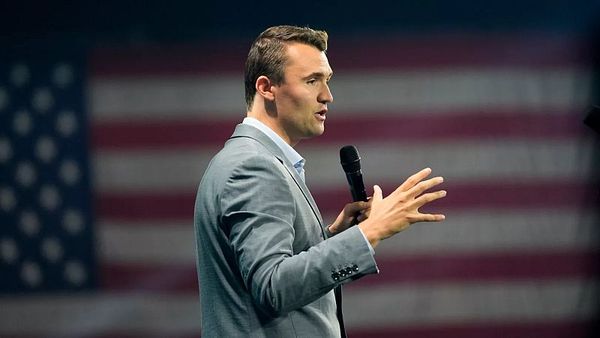Frederick Terman's name might not ring a bell for anyone addicted to their modern smartphone. But even today, he is still revered as a father of Silicon Valley.
Terman isn't as famous as some of the maverick tech entrepreneurs hailing from Northern California's vibrant tech scene. But he played the leading role in making the region the world's cutting-edge center for advanced technology.
"Frederick Terman laid the foundation for the innovation hub that it would become," said Rob Bier, executive coach and author of "Smooth Scaling: 20 Rituals to Build a Friction-Free Organization."
Much of his worked centered around making Stanford University a hotbed of tech innovation. He guided Stanford University's engineering program for 40 years, first as a top professor, Bier said. Terman later wrote advanced texts about radio during the Great Depression. And finding money for important projects helped him finance innovation — separating him from other academics who thought big thoughts were enough.
"He learned how to get contracts from the Navy and Air Force during World War II, which would benefit Stanford enormously, where he became dean in 1946 and provost in 1955," Bier said.
Terman absolutely knew true progress required brilliant individuals. But he also knew innovation takes a well-prepared, cohesive team, Bier said. Many of his students went on to found important startups. And he attracted major manufacturers to Palo Alto, Calif., by creating what is now the Stanford Research Park.
Learn To Communicate With Different Audiences Like Terman
Terman (1900-1982) was born in Indiana. But in 1905, the Terman family moved to California. His father, Lewis, a psychologist who revised and popularized the Stanford-Binet IQ test, needed warm weather to get over tuberculosis. He accepted a Stanford University professorship in 1910.
But Stanford would become part of Frederick's life, too. Stanford's president at the time, David Star Jordan, funded Federal Telegraph Corp. Federal Telegraph became a major radio company while Fred was in high school. The young Terman worked at the company in the summer — gaining key firsthand tech knowledge.
Terman also earned his undergraduate degree from Stanford. But went to MIT for an electrical engineering degree. Terman's faculty advisor there was Vannevar Bush — who taught him much more than circuits. Bush became director of President Franklin Roosevelt's Office of Scientific Research and Development. The department gave massive amount of funding to engineering schools to develop military technology. Seeing the size of government funding made a big impression on Terman. Ideas without money are just dreams.
Terman ultimately returned to Stanford. But he contracted tuberculosis and lay in bed for nine months. He didn't waste the time sleeping, though. He used the break to write a book about radio transmission. In it, he joined circuit theory with vacuum tubes and amplifiers. The book published in 1932 and became the seminal text on radio technology.
"He had a remarkable ability to understand complex material and present it in a way that was easy to grasp and addressed the needs of the audience," wrote O.G. Villard Jr. for the National Academy of Sciences.
Terman: Manage Superstars To Reach High Goals
In 1941, Bush hired Terman to run a radio research lab at MIT. It sported a staff of 850. The goal? Develop electronic countermeasures and jammers for the Navy and Air Force.
Terman developed great tact and skill in managing experts. His key? He could get engineers to approve a workable product for release — rather than fixating on making it perfect right out of the gate. Fast innovation, not the pursuit of "perfection," became a hallmark of Silicon Valley. He also signed numerous government contracts. Such funds helped bankroll Silicon Valley. In 1946, Terman returned to Stanford as the dean of the engineering school and with a plan to put it on the map as one of the top programs in the nation.
"It involved using government contracts to build a premier faculty in areas of electronics, which he was confident would experience major growth in the postwar environment," wrote Arun Rao, author of "A History of Silicon Valley." "He also created a large Ph.D. program, transforming the curriculum from one just offering practical engineering training to one rooted in the hard subjects of physics, chemistry and mathematics."
Connect With Business
Terman also led his students on tours of local entrepreneurs' labs. They included those of Bill Hewlett and David Packard. Hewlett wasn't much of a scholar but he had a knack for mechanics, while Packard was brilliant in electronics. Packard took a leave of absence from his job at General Electric to work with Terman. Terman advised Packard to get a graduate degree focused on resistance capacity oscillators. Such devices would become the first product of Hewlett-Packard.
Terman perfectly positioned Stanford for the Cold War era. In 1950, the Korean War brought in another huge infusion of government money to research electronics. So did the Soviet launch of the sputnik satellite in 1957. By this time, Stanford was celebrated as an engineering school equal to MIT, despite being much smaller.
Encourage Employees To Be Entrepreneurial
Terman recruited top professors. But asking them to simply teach didn't interest him. He wanted professors to be self-financing by paying half their salaries from grants and contracts, rather than the university's operating budget. Research associates on sponsored projects would be entirely covered from contract funds, motivating them to be entrepreneurial.
Silicon Valley led the way in venture capital in large part because the culture that Terman encouraged. He created a meritocracy. Young engineers could lead companies and young bankers could fund them. Smart venture capitalists started moving to the area to embed themselves in the contagious innovation.
Terman also dreamed up the idea to start an industrial park on 9,000 unused acres near the campus. The goal was simple, but ambitious. The park was "a means to create profitable exchange relations between industry and Stanford research labs, particularly in the area of electronics, with incentives to license Stanford inventions and establish faculty consulting relations to get their ideas into the core of industry," according to Rao.
Hewlett-Packard was one of SRP's early tenants. Terman recruited Lockheed, GE, Westinghouse and others who would become the founders of Intel, Cisco, Apple and Sun Microsystems, which acquired in 2010 by Oracle.
Maintain An Opportunity Network Like Terman
Terman rose to Stanford's provost, the highest academic officer at the university, in 1955. He held the position until his retirement in 1966, when he joined the HP board. Government contracts and grants to HP had increased from $3 million 1951 to $50 million in 1964.
"Terman was one of the most successful American administrators of science, engineering and higher education in the 20th century," wrote Rao. "He single-handedly created the university-government-industry partnership model that still characterizes Silicon Valley in the 21st century."
Terman profoundly influenced the lives of many academics while reinventing his profession, his university and the country, Villard said. If there was one theme that characterized his life and may explain his success, "it would be his ability to take advantage of opportunities, such as by maintaining contact with former students of unusual skill and friends in the industry."
Terman: Inspire The World
Silicon Valley continues to be the envy of the world. And many regions are trying to copy its success. "His vision of for the Stanford Research Park would later inspire technology-intensive clusters in Bangalore, India, and elsewhere around the world, which packed areas with companies that would work with each other and bring their relationships with customers, vendors and the workforce to Silicon Valley," wrote Edward Glaeser in "Triumph of the City: How Our Greatest Invention Makes Us Richer, Smarter, Greener, Healthier, and Happier."
Frederick Terman's Keys
- Dean and provost at Stanford University who played the leading role in creating Silicon Valley.
- Overcame: The lack of major companies, startups with great potential, and venture capital in Palo Alto, Calif., at the time.
- Lesson: "It's better to have one seven-foot jumper on your team than any number of six-foot jumpers."







